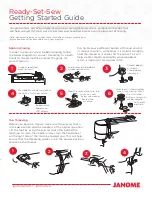
146
12. trouBlEs aND corrEctIVE MEasurEs
Phenomenon
Thread
breakage
Stitch
skipping
Loose stitch
Irregular
stitch
tightness
Needle
breakage
Cause
1
When the thread gets entangled in the thread
take-up lever.
2
When the needle thread is threaded in a wrong way.
3
When the thread gets entangled in the sewing hook.
4
When the needle thread is excessively tight or loose.
5
When the needle thread slips out of the rotary disc.
6
When the tension of the thread take-up spring is
excessively high or low.
7
When the stroke of the thread take-up spring is
excessively large or small.
8
When the timing of the sewing hook and the
needle is not matched.
9
When there is a scratch on the thread path of
hook, bobbin case, thread take-up lever or any
other part.
!0
When the thread is not suitable.
a. The quality of the thread is poor.
b. The thread is too thick for the needle.
c. The thread is broken by heat.
!1
When the stitch is skipped.
1
When the needle is inserted in a wrong way.
a. The needle is not entirely inserted into the
needle bar.
b. The needle eye is not facing straight to the
operator.
c. The needle is facing backwards.
2
When the needle itself is not suitable.
a. The needle is bent.
b. The quality of the needle is not good.
c. The needle is too thin for the thread.
d. Blunt needle is used.
3
When the hook blade point is not sharp enough or
damaged.
4
When the timing of the sewing hook and the
needle is not matched.
5
When the height of the needle bar is not correct.
6
When the clearance between the needle and the
sewing hook is too great.
7
When the needle thread slips out of the rotary disc.
(For optional auxiliary thread take-up lever type only)
1
When the needle thread tension is too low.
2
When the tension of the thread take-up spring is
too low.
3
When the tension of the bobbin thread is too high.
4
When the timing of the sewing hook and the
needle is not matched.
5
When the thread is too thick for the needle.
6
When the thread slips out of the rotary disc.
7
When the count of thread is too high.
1
When the bobbin thread tension is too low.
2
When the bobbin thread is not wound correctly.
3
When there is a scratch on the thread path of the
sewing hook, bobbin case, thread take-up lever or
any other parts.
1
When the needle is bent.
2
When the quality of the needle is not good.
3
When the needle is not entirely inserted into the
needle bar.
4
When the needle hits the sewing hook.
5
The needle is too thin for the sewing material and
thread.
6
The needle hole in the throat plate is too narrow.
7
The needle hits against the throat plate.
8
The needle hits against the presser foot.
Corrective measures
Remove the entanglement.
Thread it correctly.
Remove the entanglement.
Adjust the thread tension.
Increase the tension of the pretension disk.
Adjust the tension of the take-up spring.
Adjust the stroke of the take-up spring. (8 to 12
mm)
Adjust the timing.
Remove such a scratch or replace the
component.
Use a thread of good quality.
Use a suitable thread or needle.
Use JUKI Silicone Oil Lubricant unit.
Refer to the following paragraphs, Stitch skipping.
Fully insert the needle.
Let the needle eye face straight to the operator.
Let the long groove on the needle face to the
operator.
Replace it with a new needle.
Use a needle of good quality.
Use a suitable needle or thread.
Replace it with a new needle.
Resharpen the hook or replace it.
Adjust the timing properly.
Adjust the height of the needle bar.
Adjust the clearance.
Adjust the position of the auxiliary thread take-
up lever properly.
Increase the needle thread tension.
Increase the tension of the spring.
Decrease the bobbin thread tension.
Adjust the timing correctly.
Use a suitable needle or thread.
Increase the tension of the pretension disk.
Replace the thread tension controller with double-disk
type thread tension controller (Part No. 40017095).
Increase the bobbin thread tension.
Wind up the bobbin thread evenly.
Remove such a scratch or replace the
component.
Replace it with a new needle.
Use a needle of good quality.
Insert the needle into the needle bar as far as it
will go.
Adjust the timing and clearance between the
needle and the sewing hook and also the
position of the needle guard.
Replace a suitable needle.
See page
21
21
131
123
123
123
123
131
130, 131
19
19
19
19
130, 131
131
131
131
133
123
123
123
131
123
123
123
19
19
131



































